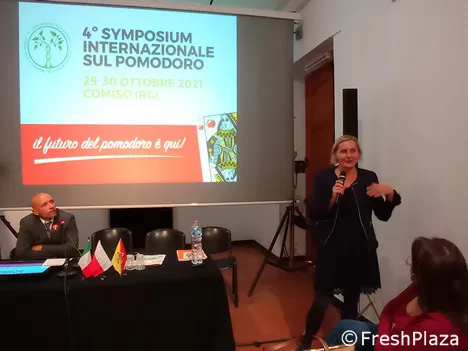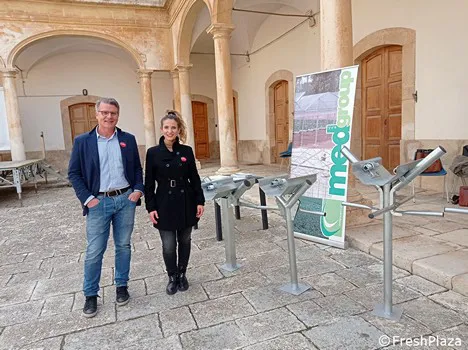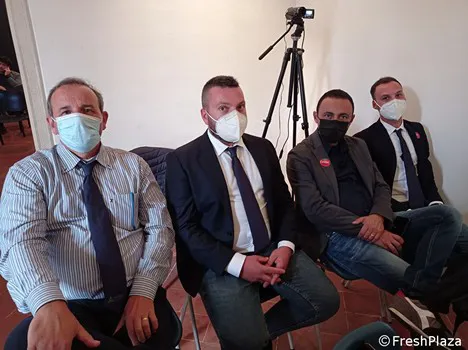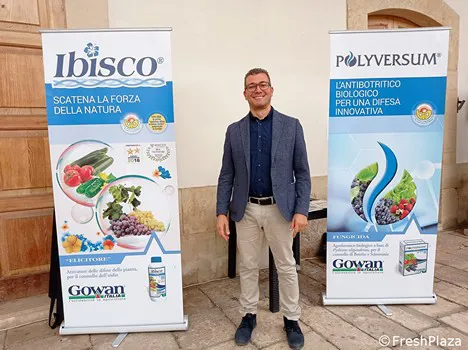On 30 October 2021, the 4th International Symposium on Tomatoes shed light on a number of issues, including the effects of rising production costs in Poland.
 Agnieszka Sekara (click here to see all the photos of the event)
Agnieszka Sekara (click here to see all the photos of the event)
After a discussion on consumer trends and on the production of tomatoes in Poland, Agnieszka Sekara, Professor of Horticulture at the University of Cracow, devoted her speech to the continuous increase in energy costs, which has already led to the closure of many high-tech production plants. In the coming weeks and months, we will see how and whether this will benefit crops from the Mediterranean area, which, as is well known, does not heat its greenhouses artificially, but only benefits from the warmth of the sun.
This was followed by the scheduled speeches of the sponsors Fomet spa, AgeonTech and TSI Italia, which were alternated with a scientific presentation by Ivana Castello from the Faculty of Agriculture at the University of Catania, on the theme of Sustainable defense against tomato telluric pathogens: current situation and future prospects. Other sponsors were Gowan Italia, Centro Seia, Koppert Italia and Centro Lombricoltura Toscano.
 The Med Group stand, with Massimiliano Nicosia and Ester Occhipinti
The Med Group stand, with Massimiliano Nicosia and Ester Occhipinti
Lastly, one of the most eagerly awaited speeches of the entire event, that of Bartlomiej Majda, a well-known consultant for Polish retailers. Majda spoke about the tomato supply chain, recounting his personal experience in this field, which started with the study of tomato seeds and ended with their placement on the market.
 TSI Italia staff
TSI Italia staff
"At the moment, the tomato production standards in Poland are not very high, which is why we are looking for new segments. The main target of my activity is the large-scale retail trade. While it was possible, we produced red tomatoes mainly for the Russian market; later, production was diversified towards pink varieties, to meet local consumer trends, which are geared towards umami taste. The national production goes to the retail channel, the remainder is marketed more traditionally, such as wholesale markets and direct sales. Competition with foreign countries is greater with Morocco, which has reduced by half the price of our national production, which is on average €2 per kg for consumption. This represents a serious problem for our production sector, which is already suffering. The highest product ranges can be as high as 10 EUR/kg at the fruit and vegetable counter. The producer is generally paid a price of around €0.80 cents throughout the year."
 Francesco Trama of Gowan Italy (Click here to see all the photos of the event)
Francesco Trama of Gowan Italy (Click here to see all the photos of the event)
"This it what the situation looked like before the disproportionate increase in energy costs. Many companies are closing down because they cannot afford the costs of heating and lighting. We're going back to the old spring/summer production cycles in order to lower costs. This will benefit the Mediterranean crops, which will benefit from the Polish winter production gap,” added Majda.
 Bartlomiej Majda
Bartlomiej Majda
“However, one should interpret this analysis with caution, because the purchasing power of the average Polish consumer must be taken into account. Poland will certainly be forced to import tomatoes and reduce exports, but this will not automatically benefit Italian products, which are quite expensive on this market. On the other hand, the Maghreb production will benefit immediately, as it already has a clear path and much more accessible costs, as shown in the comparison with the same Polish national production. It may happen that the Italian production could be favored by the need to fill the supply of tomatoes and winter greenhouse vegetables in those markets that will no longer be able to import from Poland, such as those in central and northern Europe.”
